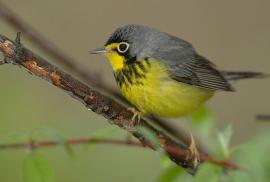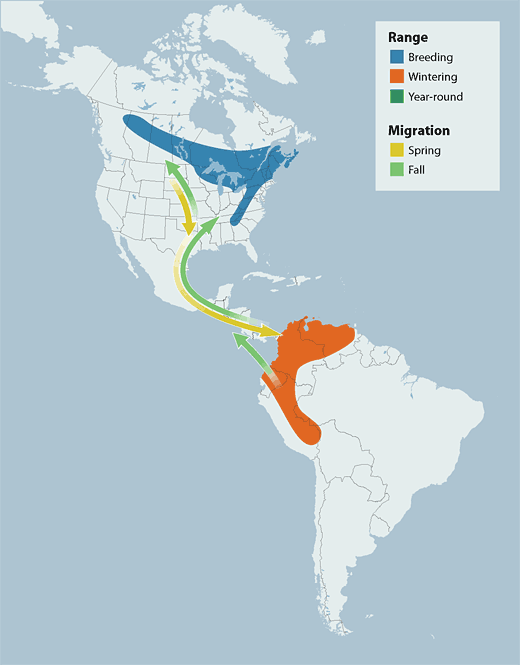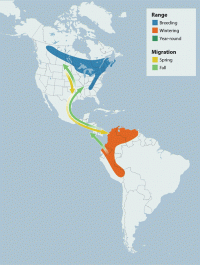Guide to Boreal Birds
This is an in-depth boreal species profile.
What is this?
This species is one of more than 30 birds selected for in-depth profiles. Find out why and see all selected boreal birds »
Overview
This brightly-colored warbler is sometimes called the Necklaced Warbler because of the band of black streaks across the male's breast. It received its name from its discovery in Canada, although it is certainly not confined to Canada, even in the breeding season. It ordinarily ranges at low levels, usually from the ground to 6 feet (nearly 2 meters) up. It catches insects on the wing more than most warblers, earning it the now obsolete names of Canadian Flycatcher and Canadian Flycatching Warbler. Flying insects form a great portion of its diet, but it also captures spiders and insect larvae. This species has yet to receive intensive study and much of its biology remains unknown. On the breeding grounds it tends to be associated with mixed deciduous-coniferous woodlands. Steep declines in recent decades have made this species a high conservation priority.
Description
5" (13 cm). Solid gray above, without wing bars, yellow below; yellow "spectacles"; black-spotted "necklace" on breast. Female similar but duller, with only a trace of necklace.
Voice
A rapid, sputtering warble.
Nesting
4 brown-spotted white eggs in a nest of dried leaves and grass, on or near the ground at the base of a stump or in a fern clump.
Habitat
At all times of year, the Canada Warbler is a bird of moist thickets. It nests in riparian thickets, brushy ravines, forest bogs, etc. at a wide range of elevations and across a variety of forest types. In the northwestern parts of its range it frequents aspen forests; in the center of the range, it is found in forested wetlands and swamps; and in the south it occupies montane rhododendron thickets. It is somewhat more catholic during migration, opportunistically utilizing brushy areas in a wide variety of moist woodlands, parks, swamps, scrub, and forests. In winter it tends to prefer mid- and upper-elevation habitats and has been found in coffee plantations and hedgerows. There is some evidence of altitudinal segregation by the sexes on the winter grounds.
Range/Migration
The Canada Warbler spends less time on the breeding grounds than most species, being one of the last to arrive and first to depart; the total time on the breeding grounds may be no more than two months. It migrates at night, rapidly and synchronously, seldom being found anywhere for more than three weeks. Despite observations of pairs traveling together, males generally arrive slightly ahead of females. The migration path is generally south and west to the Texas coast, then along the Gulf Coast to southern Mexico. From there the birds move inland to the mountains or cross over to the Pacific and continue south to the winter grounds in northwestern South America, arriving in late September to early October. The winter range extends around the northern and western side of the Andean crest from western Guyana to northwestern Bolivia. Spring migration is also late and compressed, beginning late March to mid-April. Peak passage as far south as Panamá may be as late as early May. Populations in the western part of the winter range may cross the Pacific to southern Mexico in spring and most birds seem to cross North American farther east in spring than in fall.
Breeding
The Canada Warbler breeds across the southern boreal region, from extreme southeastern Yukon to Nova Scotia, and south to the Great Lakes region, New England, and higher elevations of the Appalachians to Georgia. An estimated 60-65% of the population nests in Canada's boreal region. It is at least seasonally monogamous; pairs have been observed together on migration in Central America and it has been suggested that pair bonds may be permanent, contradicting the evidence that the sexes winter at different elevations. Nests, built by the females, are placed on or very close to the ground in dense cover. Nest sites include root masses, hummocks, stumps, stream banks, mossy logs, and less often in leaf litter, grass clumps, rock cavities, and brush piles. Moss is a frequent element. Clutch size is 2-6, usually 4-5. The incubation period is about 12 days; female apparently does all incubation . The male often follows the female during foraging bouts. Both parents feed the young, which fledge at about 8-10 days, still unable to fly. Nest parasitism by cowbirds is frequent where cowbirds occur, in the southern parts of the range. As with other long-distance migrants, there is only one brood per year.
Diet/Feeding Behavior
Like other warblers, the Canada Warbler eats insects for the most part, supplemented by spiders, snails, worms, and, at least seasonally, fruit. Flying insects, especially flies, make up the bulk of the diet. It employs a wide variety of foraging tactics, often flushing insects from foliage and catching them on the wing. It also gleans from branches and occasionally on the ground and hover-gleans. As with many other warbler species, males tend to forage higher than females on the breeding grounds. It often joins mixed-species flocks in winter.
References
Blancher, P. 2003. The importance of Canada's boreal forest to landbirds. Canadian Boreal Initiative, Ottawa, ON.
Conway, C. 1999. Canada Warbler (Wilsonia canadensis). In The Birds of North America, No. 421 (A. Poole and F. Gill, eds.). The Birds of North America, Inc., Philadelphia, PA.
Francis, C. M., and F. Cooke. 1986. Differential timing of spring migration in wood-warblers (Parulinae). Auk 103:548-556.
Krause, H. 1965. Nesting of a pair of Canada warblers. Living Bird 4:5-11.
Sauer, J. R., J. E. Hines, and J. Fallon. 2004. The North American Breeding Bird Survey, Results and Analysis 1966 - 2003. Version 2004.1. USGS Patuxent Wildlife Research Center, Laurel, MD.
Sodhi, N. S., and C. A. Paszkowski. 1995. Habitat use and foraging behavior of four Parulid warblers in a second-growth forest. Journal of Field Ornithology 66:277-288.
Wells, J.V. 2007. Birder’s Conservation Handbook: 100 North American Birds at Risk. Princeton University Press: Princeton, NJ.
Credits
Birding content provided by National Wildlife Federation/eNature, with support from Ducks Unlimited/The Pew Charitable Trusts.





